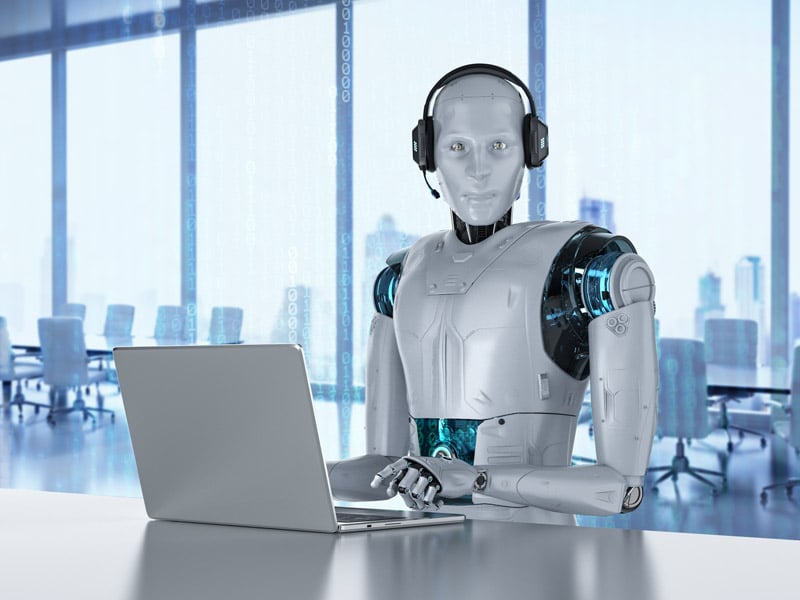
Artificial intelligence (AI) and augmented reality (AR) are rapidly driving companies to digitalize, and these processes are affecting the way IT is organized, too. Now, in addition to being responsible for end user support and hardware and software installation, IT is now expected to help out when it comes to user onboarding and processes analyses as well. Performing these labor-intensive tasks on a routine basis means less time is available for providing comprehensive user support or focusing in on more complex issues. This can result in hasty and even insufficient or unintelligible answers in service management, ultimately lowering satisfaction levels among employees, end users, and IT. Consequently, the entire company may give the outward appearance of being disorganized.
So how can companies lower the volume on all this ‘static’ to free up more time for relevant tasks? Employing artificial intelligence (AI) in the form of chatbots presents an excellent opportunity to face the challenge head-on. This trend is documented in the IDC study ‘Future of Work in Germany 2018.’ The study found that half of all IT managers from the 307 companies surveyed predicted that colleagues from their department would have daily contact with an AI-based smart agent within five years’ time.
Chatbots are almost human
Thanks to the use of AI in data analysis and natural language processing (NLP), modern chatbots can help out by answering and processing most frequently asked questions and concerns automatically. On top of that, these digital helpers aren’t limited to standard work hours. They support IT in the face of increasing digitalization and the demand for 24/7 availability.
Earlier versions of these chatbots were of limited appeal. As they relied on pre-defined troubleshooting flowcharts and a finite pool of questions and answers. As a result, they were unable to produce any tangible improvements. NLP enables modern bots to understand the context of the questions. And to comprehend a wide range of different ways of expressing ideas. That makes them seem almost human, a fact which significantly increases acceptance among end users. Bots that are specially tailored to the company. And its use cases have been found to have a measurable positive influence on the user experience. By automatically processing frequently asked questions, bots are also able to free up IT staff for other tasks.
Data quality as the basis for AI
Prior to integrating a chatbot into its system, the company must garner support for the initiative from the majority of its user base. The next step is for IT staff to check the quality of all data to be used. After all, this information will serve as the basis for the company’s AI. In addition, it will be necessary to determine the degree of interaction permitted. Should the bot serve exclusively as the first point of contact to provide users with rapid, round-the-clock service? Or should a query be simultaneously sent to existing service desk or request systems in the background? Today it’s even possible for chatbots to trigger tickets and orders for customers.
Once all processes have been defined, the next order of business is to find an appropriate solution. Before the implementation, the company must plan for a substantial test phase to be conducted in close concert between IT and a defined pool of users.
Acceptance is the top priority
Acceptance tends to be highest when new solutions are integrated into existing systems. In this case, the latter may consist of a service desk, a service management solution, or a company-wide chat platform.
When selecting an appropriate tool, the company must ensure that its choice has a sufficient range of functions. A simple chat program is a good start. But it is advisable for companies to integrate new solutions into their company-wide communication systems. This type of integration makes it possible to transfer cases directly from a chat to a service desk agent. Who can then proceed to process these queries. The chatbot, which is connected to service management in the background, can inform the user once the agent is finished. This strategy enables 360°-integration in the company and provides added value for everyone involved, not to mention considerable cost savings.
Better employee experience
Chatbots are poised to play an important role in our day-to-day lives. Both at work and at home – by automatically completing repetitive, routine tasks for us. They also offer companies the incredible opportunity to dramatically improve the user experience. These bots give employees the comfort of knowing that their queries are being processed around the clock. And that their problems will be solved as quickly as possible. The company benefits from conveying an image of itself as modern and innovative. This is advantageous in both employee recruiting and retention. After all, highly-qualified specialists and young professions alike are attracted to employers on the cutting edge of technology.
In the IDC study ‘Future of Work in Germany 2018,’ 41 percent of respondents belonging to Generation Y (between 24 and 38 years of age) perceive their current employer to be behind the times when it comes to innovation in IT workplace modernization. Half of all respondents between 16 and 23 years of age (Generation Z) indicated that the clients, applications, and collaboration tools at their company are out of date. Today’s managers and the next generation of young professionals expect a modern working environment to suit their needs. The study also shows that companies employing cutting-edge organizational methods tend to be more successful, too.